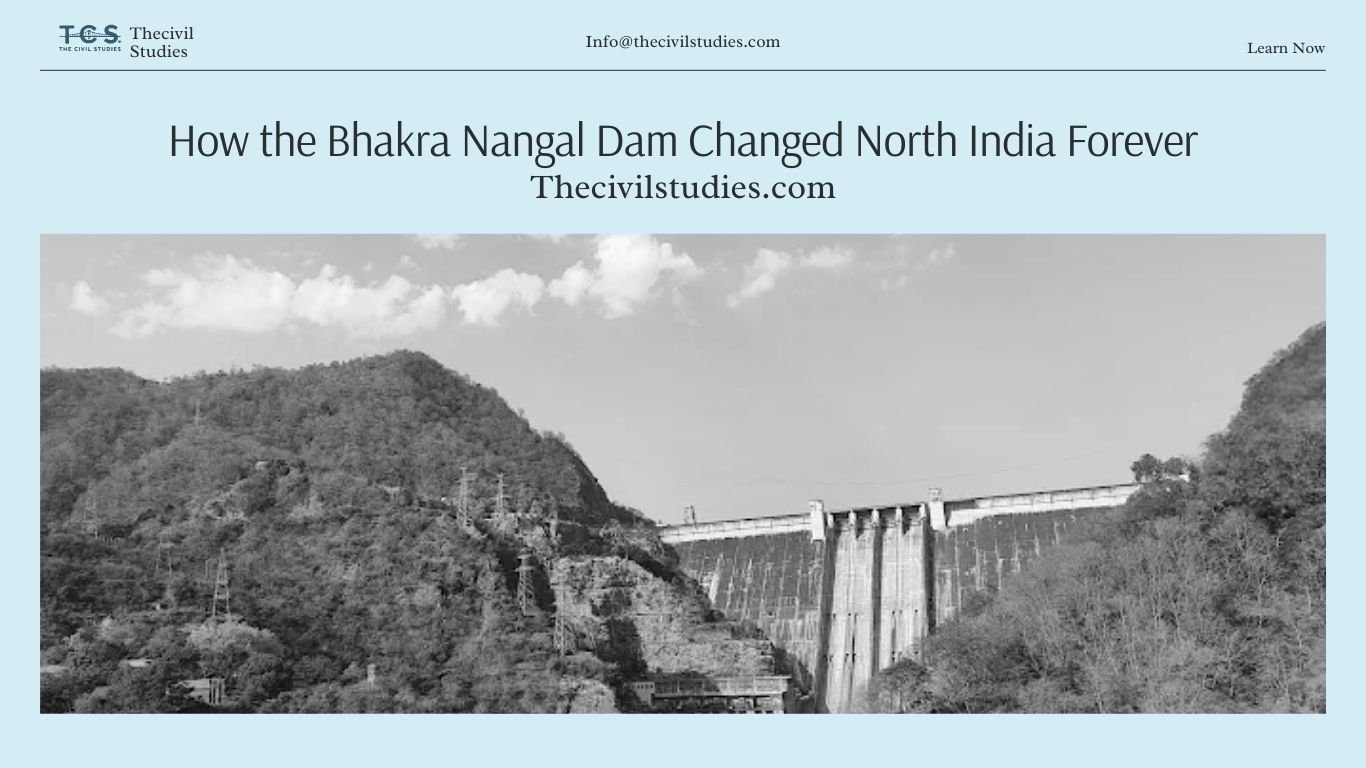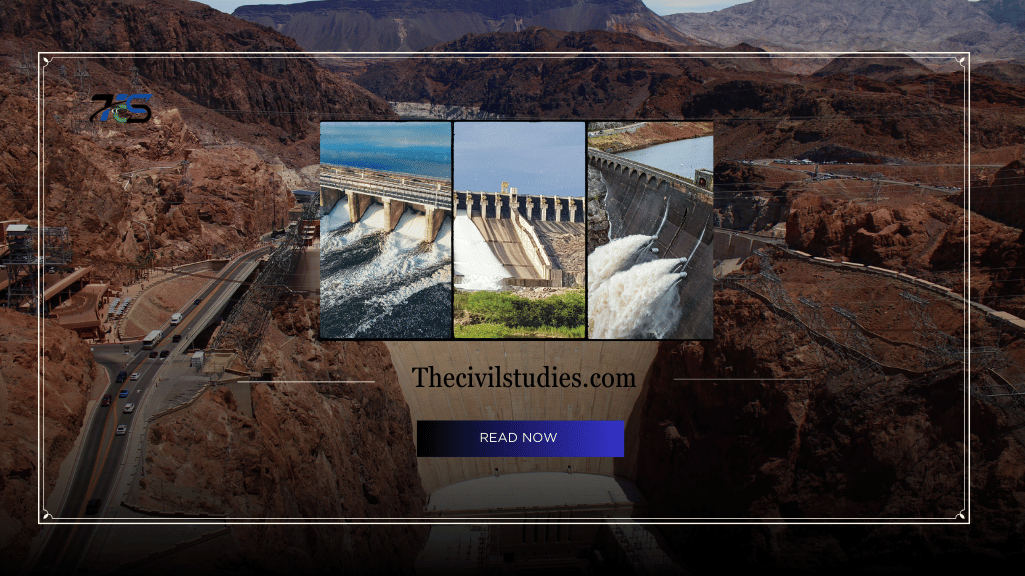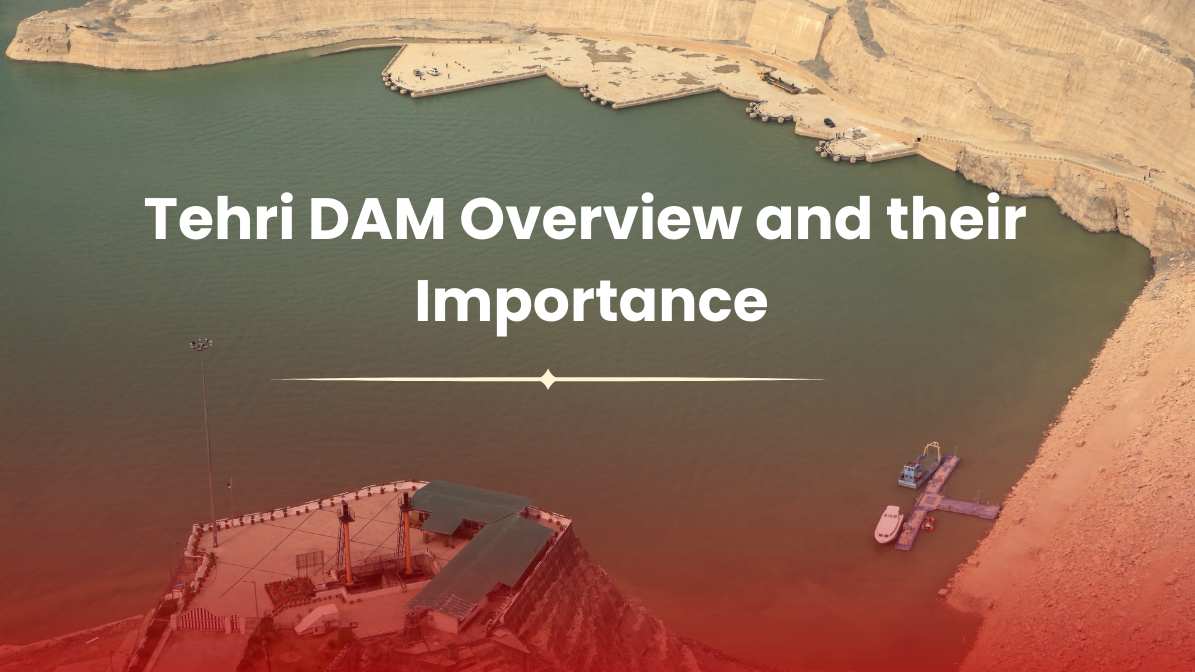What if I told you that a single dam transformed vast dry lands into fertile fields, powered millions of homes, and became a symbol of India’s strength in the early years after independence?
That dam is the Bhakra Nangal Dam.
Nestled between the rugged hills of Himachal Pradesh and Punjab, this towering structure is much more than just concrete and steel. It is a lifeline — a turning point, a dream realized when India was just beginning to stand on its own.
A Nation’s Challenge and a Visionary Response
After 1947, India was brimming with hope but faced enormous challenges. Floods ravaged crops, droughts parched the land and vast parts of rural India remained without electricity. The future was uncertain.
In this turbulent time, the idea of Bhakra Nangal was born — not merely to control floods or store water, but to build a new nation.
This story isn’t just about engineering. It’s about visionaries- engineers and thousands of workers who believed in something bold — something unprecedented in India’s history. Brick by brick, they built not just a dam, but trust, resilience, and a brighter future.
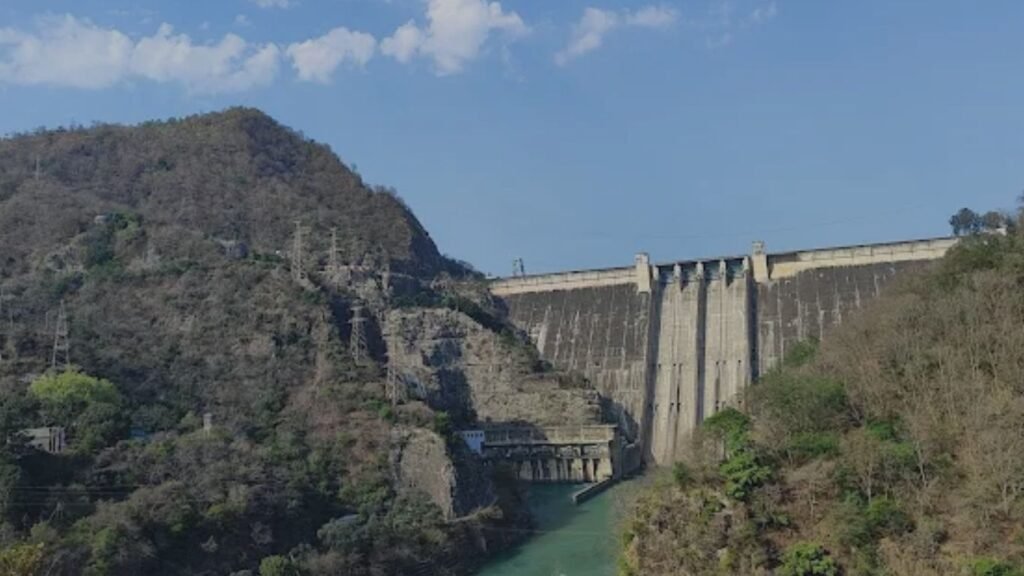
The Historical Imperative: Birth of the Bhakra Nangal Project
Water Emergency After Partition
When India gained independence in 1947, Punjab — known as the land of five rivers — lost much of its irrigation infrastructure to Pakistan. Once fertile fields turned dry, floods destroyed lands, and millions of refugees added pressure on limited resources.
India’s survival depended on securing reliable water supply — controlled, stored, and delivered. From this urgent need, the vision of the Bhakra Nangal Project emerged.
From Vision to Action
Although early surveys in the 1920s identified the Sutlej River’s potential, it wasn’t until 1944, with key agreements and engineering leadership, that the project gained momentum.
Construction officially began in 1948. Over 15 years, thousands of workers and engineers built what became India’s tallest dam at that time — rising 226 meters high. The resulting Gobind Sagar Reservoir became a crucial resource for northern – India.
“Temple of Resurgent India” — Nehru’s Pride
When Prime Minister Jawaharlal Nehru visited the site in 1955 and poured the first ceremonial bucket of concrete, he saw more than an engineering feat. He saw India’s self-belief.
He called Bhakra the “New Temple of Resurgent India,” symbolizing a future powered by freedom, science, planning, and determination.
By its inauguration in 1963, Bhakra Nangal had become a national achievement, a beacon of what India could accomplish.
Fueling the Green Revolution, Turning Dry Soil to Golden Fields
During the 1960s and 70s, India faced food shortages and depended heavily on imports. The Green Revolution introduced high-yield crops but demanded reliable irrigation.
Bhakra was the unsung hero, irrigating over 10 million acres across Punjab, Haryana, and Rajasthan. It enabled multiple harvests annually and transformed drought-prone lands into India’s breadbasket- helping feed millions.
Without Bhakra’s waters, the Green Revolution wouldn’t have flourished.
Powering the White Revolution and Beyond
As India sought self-sufficiency in milk production, led by Verghese Kurien and the White Revolution, electricity was essential for dairy plants and cold storage.
Bhakra’s hydroelectric power — with a capacity of 1,325 MW — lit up homes, industries, and rural milk cooperatives across North India. It helped India become the world’s largest milk producer – powering livelihoods and prosperity.
The Legacy Lives On – Bhakra’s Ongoing Impact
Decades later, Bhakra Nangal still stands tall—literally and metaphorically.
- It prevents devastating floods in Punjab and Himachal Pradesh.
- It continues to provide clean hydroelectric power to millions.
- It fuels industrial growth, supports urban expansion, and powers digital India—quietly and consistently.
2. Strategic Site Selection and Geological Considerations
2.1 The Bhakra Gorge – A Natural Engineering Marvel
The choice of Bhakra as the dam site was a product of both rigorous scientific analysis and remarkable natural advantages. The location features a narrow gorge on the Sutlej River, approximately 518.25 meters Long and 9.1 Meter Wide, bounded by massive, stable sandstone formations of the Lower Himalayas. This natural constriction provided an ideal foundation for a high concrete gravity dam, capable of efficiently resisting the immense hydrostatic pressure of the reservoir.
Crucially, the sandstone bedrock exhibited exceptional strength and minimal permeability, significantly reducing the risk of seepage beneath the dam. The natural topography also minimized excavation requirements, optimizing construction costs and time. Local folklore—such as the famed tiger leap across the gorge—illustrates the natural narrowness and strength of this geological feature, highlighting how nature and engineering vision aligned perfectly.
Recommended Reads for You
2.2 Comprehensive Geological and Hydrological Investigations
Prior to construction, exhaustive multidisciplinary surveys were undertaken to ensure long-term structural stability and operational safety. These investigations included:
- Seismic Hazard Analysis: Detailed seismic risk assessments were performed, mapping fault lines and evaluating potential earthquake magnitudes to design the dam to withstand significant tectonic forces prevalent in this seismically active Himalayan region.
- Geotechnical Studies: Core drilling and rock sampling assessed the mechanical properties of the sandstone and underlying strata. The foundation treatment design incorporated curtain grouting and drainage galleries to control uplift pressure and prevent seepage through fissures.
- Hydrological Modeling: Extensive data collection on the Sutlej River’s flow regime, including peak monsoon runoff, seasonal variations, and flood frequency, enabled engineers to accurately size the reservoir capacity of approximately 9.34 billion cubic meters. Spillway design accounted for extreme flood events to ensure dam safety.
- Slope Stability and Erosion Control: The adjacent hillsides were analyzed for landslide susceptibility, and appropriate slope stabilization measures, including retaining structures and vegetation cover, were planned to protect the reservoir and infrastructure.
3. Engineering Challenges and International Expertise – Building the Impossible
3.1 A Nation’s Ambition Meets Limited Experience
In the late 1940s, India was still a young nation with big dreams but limited experience in executing large-scale engineering projects—especially one of the magnitude of the Bhakra Nangal Dam, which would rise to a height of 226 meters (741 feet). At that time, no Indian infrastructure had come close to this scale.
India’s civil engineering workforce was talented but untested when it came to constructing a high concrete gravity dam capable of withstanding immense hydrostatic pressures, seismic forces, and long-term environmental exposure. Equipment, materials, and machinery needed for such a colossal effort were also either outdated or unavailable within the country. The ambition was there—but the know-how needed reinforcement.
3.2 The American Visionary – Harvey Slocum Steps In
Recognizing these gaps, the Indian government sought international expertise. In a visionary move, they appointed Harvey Slocum, a seasoned American dam builder known for his work on large hydraulic structures, including the Grand Coulee Dam in the U.S. Slocum was not just brought in as a figurehead—he was given full operational control, with the power to fast-track decisions, bypass red tape, and directly procure cutting-edge equipment from abroad.
He arrived with a handpicked team of over 30+ international experts, including specialists in civil, mechanical, and electrical engineering. Their presence marked one of India’s first global collaborations in engineering—a fusion of western technology and Indian manpower.
Slocum’s influence was deeply practical. He introduced:
- Modern concrete placement techniques
- Quality control protocols unheard of in India at the time
- Efficient project management systems
- Custom machinery and design improvisations adapted to Indian terrain and materials
His ability to navigate both the technical and administrative hurdles gave the project momentum at a critical juncture.
3.3 A Revolutionary Approach: Departmental Construction Model
Rather than assigning the work to a private construction firm—a common practice then—the Bhakra Dam was built departmentally, directly under government supervision. This was a groundbreaking decision.
Slocum and his team trained hundreds of Indian engineers and supervisors on-site, essentially creating India’s first generation of large-dam specialists. These engineers didn’t just build the dam—they learned how to build it, setting the stage for future projects like the Nagarjuna Sagar and Tehri Dams.
This “learning-by-doing” model was more than just an efficient choice; it was a nation-building initiative. It empowered local expertise, reduced dependency on foreign firms, and nurtured a culture of engineering excellence that still benefits India today.
4. From Blueprints to Reality: Building Bhakra Step by Step
4.1 The Human Cost: When Progress Submerged Villages
Behind every great dam lies a story of sacrifice. To make way for the Gobind Sagar Reservoir, 371 villages were submerged, and over 36,000 people had to leave their ancestral homes. The government provided resettlement in the form of new housing, schools, and healthcare. But for many, no compensation could replace the emotional loss. Even today, Bhakra’s story is incomplete without acknowledging this profound human trade-off.
4.2 Timeline: From Dream to Concrete Reality
- 1946–1948: Early groundwork begins amidst the chaos of Partition.
- 1948: Official construction launch—India sets its sights on self-reliance.
- 17 Nov 1955: Nehru pours the first concrete, calling it the “Temple of Modern India.”
- 1958: Diversion tunnels completed—water safely redirected for construction.
- 1962: Gobind Sagar reservoir begins filling, bringing new hope to agriculture.
- 22 Oct 1963: Dam officially inaugurated—a national milestone in infrastructure.
4.3 Innovations That Changed Indian Engineering Forever
Roller-Compacted Concrete (RCC): Revolutionizing Mass Concrete Work – Instead of using conventional poured concrete, engineers used roller-compacted concrete (RCC) for large-scale structural components like the dam body.
- Why it mattered: RCC is drier and stiffer than normal concrete and can be laid down using heavy rollers, similar to road construction.
- Benefits:
- Faster placement over large areas
- Reduced setting time
- Lower cost due to minimal formwork
- Improved durability for massive structures
- Result: Enabled faster progress without compromising structural integrity—a major breakthrough for Indian dam construction.
2. Round-the-Clock Construction: The 3-Shift Model – To meet aggressive deadlines, the project adopted a three-shift system of 8-hour work cycles, running 24/7.
- Why it mattered: This was one of the first Indian infrastructure projects to implement continuous operations, similar to industrial manufacturing.
- Impact:
- Maximized productivity
- Optimized equipment usage
- Reduced overall construction time
- Legacy: Set a precedent for future high-priority national projects.
3. On-Site Batching Plants: Precision in Concrete Quality – To ensure consistent concrete strength, dedicated batching plants were set up on-site.
- How it helped:
- Controlled mix ratios and quality
- Reduced delays from transporting ready-mix concrete
- Streamlined the supply chain for raw materials
- Why it was important: Uniformity in concrete quality was essential for a dam of this height (226 meters) and water pressure.
4. Conveyor Belt Systems: Automating Material Handling – Instead of relying solely on manual labor, Bhakra used mechanized conveyor belts to transport sand, aggregates, and cement across the construction zone.
- Key Advantages:
- Reduced reliance on physical labor
- Increased material transport speed
- Minimized loss and spillage
- Result: Boosted operational efficiency and ensured timely delivery of construction materials, even in remote or hard-to-access areas.
4.4 Technical Specifications
| Specification | Details | Explanation |
|---|---|---|
| Dam Type | Concrete Gravity Dam | Uses its own weight to hold back the water |
| Height | 226 meters (741 feet) | One of the tallest dams in India |
| Crest Length | 518.25 meters (1,700 feet) | Total length across the river gorge |
| Base Width | 192 meters (630 feet) | Width at the base for stability against water pressure |
| Crest Width | 9.1 meters (30 feet) | Width at the top, includes road for maintenance |
| Reservoir Gross Capacity | 9.621 billion cubic meters (339.73 tmc ft) | Total water storage capacity |
| Live Storage Capacity | 6.007 billion cubic meters | Water available for irrigation and power generation |
| Reservoir Surface Area | 168.35 square kilometers | Area covered by water when reservoir is full |
| Catchment Area | 56,980 square kilometers | Total land area draining into the reservoir |
| Spillway Capacity | 27,000 cubic meters per second | Maximum water flow the dam can safely release during floods |
Power Generation and Flood Control: Engineering at Its Best
5.1 Spillway and Flood Management
- 11 Gated Spillways: Designed for controlled water release, these gates manage overflow during heavy rains or floods.
- Maximum Discharge Capacity: Can safely release up to 27,000 cubic meters per second, ensuring the dam’s safety against extreme flood events.
5.2 Main Powerhouses
- Two Powerhouses: Located on the Left Bank and Right Bank of the dam.
- Turbines: Each powerhouse contains 5 Francis turbines—reliable machines ideal for medium to high head hydroelectric power.
- Capacity:
- Left Bank: 5 turbines × 126 MW = 630 MW
- Right Bank: 5 turbines × 157 MW = 785 MW
- Total Installed Capacity: 1,325 MW
- Commissioning: Both powerhouses became operational between 1962 and 1963.
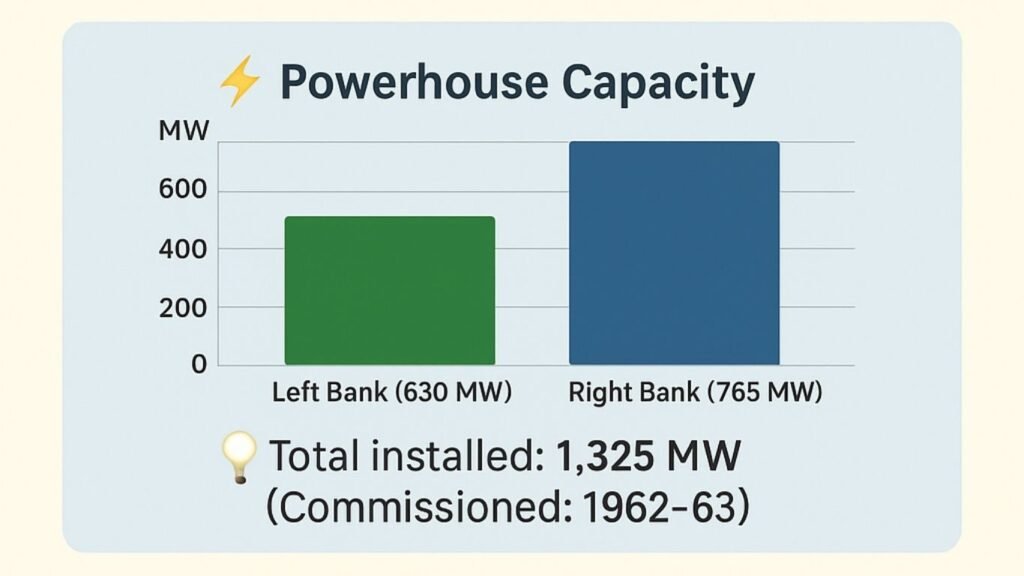
5.3 Canal-based Hydroelectric Plants
- In addition to the main powerhouses, three smaller hydro plants on canals downstream add significant power:
- Ganguwal Plant: 77.65 MW
- Kotla Plant: 77.65 MW
- Anandpur Sahib Plant: 134 MW
- Combined Additional Capacity: Approximately 289.3 MW, contributing to local power supply and efficient use of canal water.
Legacy and Lessons for Future Projects
The Bhakra Nangal Dam exemplifies visionary planning, technical innovation, and the power of international collaboration. Its success offers vital lessons on balancing engineering ambition with environmental stewardship and social responsibility. Today, as India seeks to expand renewable energy and water storage infrastructure, Bhakra’s blueprint continues to guide policymakers and engineers.

